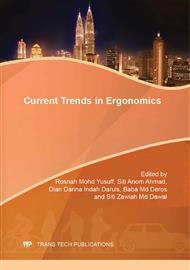p.154
p.160
p.167
p.173
p.178
p.184
p.190
p.199
p.207
Design of an Ergonomic Gaming Console
Abstract:
The average gamer faces a number of musculo-skeletal injuries due to bad design of keyboards, consoles, mice, workspace layout and a number of other factors. This study aims at minimizing injuries and maximizing human comfort by using Ergonomic principles in the design of the console, which also happens to be the main interactive device between the gamer and the computer. Hence the objective of this study would be to design a keyboard to optimize the comforts of using a gaming console for computer games played on the keyboard, through the sciences of anthropometry and ergonomics.
Info:
Periodical:
Pages:
178-183
Citation:
Online since:
December 2013
Keywords:
Permissions:
Share:
Citation:


